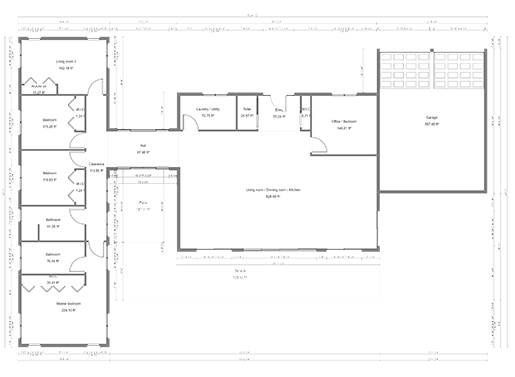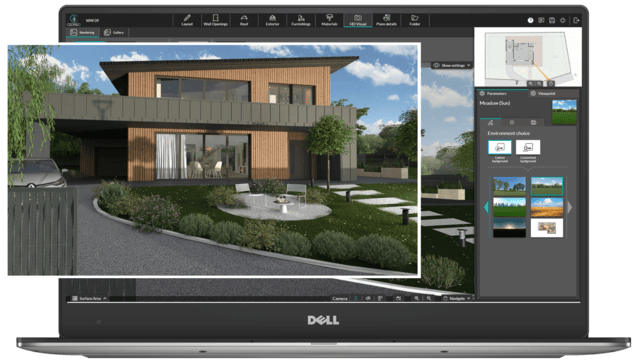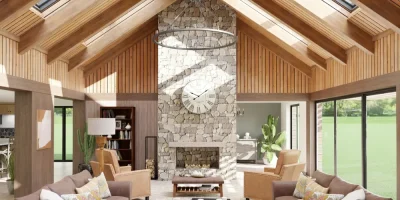What’s the number one marketing tool for real estate professionals? There are plenty of great options to choose from: SEO, social media, billboards and more.
But none of those possess the same sale-closing power as marketing floor plans.
It’s true — the humble floor plan can be used for marketing in real estate. And it works really, really well.
It’s as simple as it sounds: floor plans for real estate marketing are just floor plans. They can be 2D, 3D and even photorealistic and tourable. They get the attention of your target audience. They tell potential buyers nearly everything they need to know about the property.
And with the right software, you can create them in minutes and close more deals quickly — listings with marketing floor plans spend 50% less time on the market.
In this post, we will take a closer look at real estate marketing floor plans, how to create them and how they can benefit your business. Keep reading to learn more.
What is a Marketing Floor Plan?
Marketing floor plans are both surprisingly simple and deceptively complex. They’re simple because they are floor plans — the ones you’ve seen a thousand times. But they’re complex because you can enhance their marketing power by opting for 3D and photorealistic renderings.
When used in real estate listings, floor plans evolve from an informational tool into a marketing powerhouse. They provide a top-down view of any property that tells potential buyers what they need to know. That way, when they contact your firm, you already have them on the hook.
What’s Included in a Marketing Floor Plan?
Any floor plan used for real estate marketing purposes is technically a marketing floor plan, but the things you include in the floor plans can make or break a floor plan’s marketing power.
Here are some items to consider including in your floor plans:
- Room labels
- Wall lengths and heights
- Room dimensions
- 3D furniture and 2D furniture symbols
- Interior decorations
- Outdoor areas
The more detail you include, the more powerful the picture in your prospective buyers’ minds will be. Having a clear picture of the property — but without empty rooms or other people’s things — creates an emotional connection with the listing in the buyer’s mind. And that makes the sale much more likely to happen.
Types of Marketing Floor Plans
Real estate marketing floor plans can look different from listing to listing, but there are two basic types: 2D and 3D.
- 2D – B/W or Color
A 2D floor plan shows the view of the property from above. It’s the classic floor plan. It’s usually in black and white, but adding color can bring even this flat representation of the property to life.
In a 2D floor plan, you want to have plenty of information. Include symbols to represent all the visual information a potential buyer would need. For example, you need symbols to show doors, windows, walls, appliances, furniture and even outdoor features.
However, symbols can only get you so far with a 2D floor plan. You will also need to include text to show things like square footage, room dimensions and the purpose of each room.

- 3D
A 3D marketing floor plan takes all the information you can glean from a 2D floor plan and represents it with high-quality, three-dimensional visuals. Where you once had the word “Closet” in the 2D floor plan, you will have a bird’s-eye view of the inside of the closet, complete with details like a hanger rack and even interior lights. Symbols to show where plants or dining room tables could go will be actual 3D images of these items in your 3D floor plan.

How to Create 3D Real Estate Marketing Floor Plans
The marketing potential in 3D floor plans is enormous, but to take advantage of it, you will actually have to create some floor plans for your listings. There are three basic ways to do that: outsourcing, CAD software and simple home design software.
- Outsource floor plans
Some real estate firms hire outside parties to create 3D floor plans. These outside parties have a lot of design skills, but they come at a high price. That added expense drives down your margins. Also, it takes a ton of time, and when you finally do get your 3D floor plan, you’re not able to easily rework it if a client has some feedback on it.
- Use CAD software
If you have CAD skills, you can create 3D marketing floor plans inside a traditional CAD program. The problem, however, is that you’re a real estate professional — not a trained architect — so you probably don’t have a ton of CAD skills. Make no mistake: the CAD learning curve is steep. On top of that issue, the software is extremely expensive, so it’s a huge investment to even try CAD.
- Use simple home design software
The third way to create 3D floor plans for real estate marketing is with a simple, effective home design software. Cedreo, for example, allows you to cut typical drafting time in half with intuitive features like instant 3D rendering, automatic surface area calculations and continuous drawing mode. You can even see your 3D floor plan and 2D version simultaneously as you draw. Software like Cedreo can save you a ton of time and create breathtaking floor plan visualizations that are guaranteed to close more deals — all for much less than the cost of a CAD program or outsourcing your designs.

How Marketing Floor Plans Benefit Builders and Real Estate Agents
Real estate marketing floor plans provide big benefits to real estate agents and home builders alike. But how, exactly, do they do that? See below.
1- Attract potential customers
Both in print and online, high-quality visuals get attention. When you’re trying to get the attention of home buyers, there’s no better visual to use than a 3D floor plan. After all, your customer wants to see homes for sale. You can give them what they want to see with marketing floor plans.
2- Create engaging visual content
Content is king in marketing, but where should real estate professionals get the content they need for their marketing efforts? Floor plans are a great place to start. Each floor plan is an engaging standalone image, and it tells the story of the listing. Spice the image up with 3D furniture and landscaping accents, and heads will start turning.
3- Improve targeted advertising
This happens in real estate all the time: a potential buyer calls about a bland listing with no floor plan. They schedule a showing, and the moment they set foot inside the home, they realize it’s not right for them. They see some aspect of the home that won’t work for them, and it’s over — time wasted for them and the agent. That’s the opposite of targeted advertising. To better target engaged leads, use floor plans. By providing a floor plan on the listing up front, you weed out those who are ultimately not going to be interested in buying the property.
4- Enhance marketing materials and listings
Real estate is incredibly competitive. Every agency is trying to outcompete the others in their listings and marketing materials. Looking for a way to make your listings, ads, social media posts and more pop? Floor plans will do the trick every time. Floor plans work great as visual assets in both traditional and online ads, and they make your listings stand out from the competitors who haven’t gotten on the floor plan bandwagon yet.
5- Help sell difficult real estate
Sometimes, a property has great bones but terrible presentation. There may be surface damage or deterioration that immediately turns buyers away. A floor plan can help potential buyers see the home beneath the surface — the bones. That way, they can picture what the home could be instead of what it is right now.
6- Avoid unnecessary site visits
With a detailed 3D floor plan, you can cut out a lot of wasted time for yourself and potential buyers. You can “show” the property remotely with the floor plan. This is particularly useful if the buyer is far away from the area.
7- Show exact dimensions
One really nice thing about floor plans is that they show the dimensions of each room. You don’t get that kind of detail in an in-person visit, but it is need-to-know information for your customers. They need to know how their furniture will fit into particular rooms, and a floor plan can tell them that.
8- Understand client preferences
As you’re working with a buyer, you can use floor plans to zero in on exactly the kinds of properties that will appeal to them. Without having to visit a ton of houses, the buyer can look at a few floor plans and tell you what they do and do not like. You use that information to find properties that you know they’ll like.
9- Show comparisons
If you’re building a new home or remodeling an existing one, you can use floor plans to help clients understand what the property will look like after the work is done. People sometimes need a visual aid to fully understand and commit to an idea, and that’s exactly what a floor plan will give them.
Create a Professional Marketing Floor Plan
You know what marketing floor plans are, how they help real estate professionals, and how to make them. Now, all you have to do is start drawing.
You have some choices when it comes to floor plan drawing software, but none will come close to Cedreo in ease of use or intuitive features. With Cedreo, you can easily create and download real estate marketing floor plans and share them with clients or use them in marketing materials. Choose from thousands of pre-built 3D decorations and pieces of furniture, import existing floor plans or create your own and start making your real estate marketing efforts really work for you.
Cedreo is easy to use and free to try. So, there’s nothing to lose and a lot of home sales to gain. Try Cedreo for free today with no commitment or hidden fees. The fun starts when you start drawing floor plans, but the magic is going to begin when the sales start pouring in.



